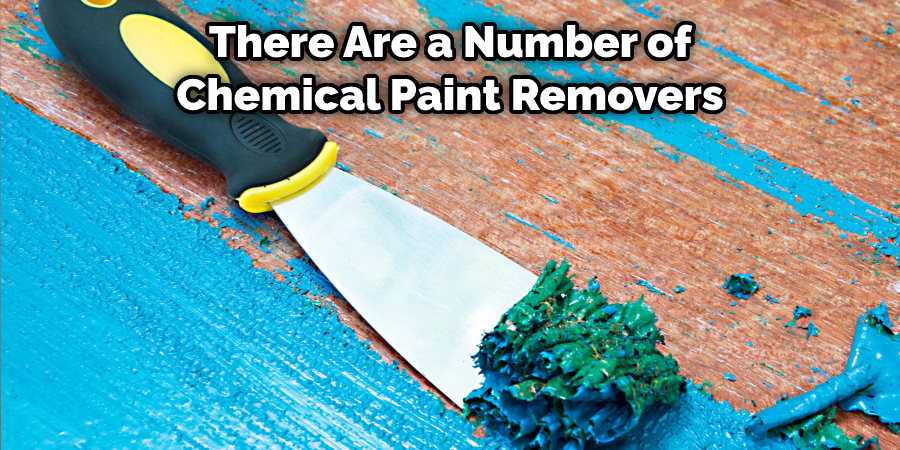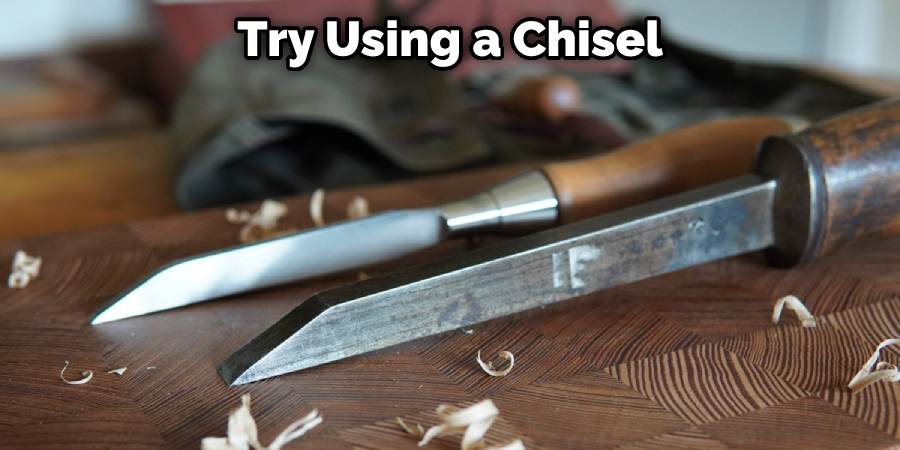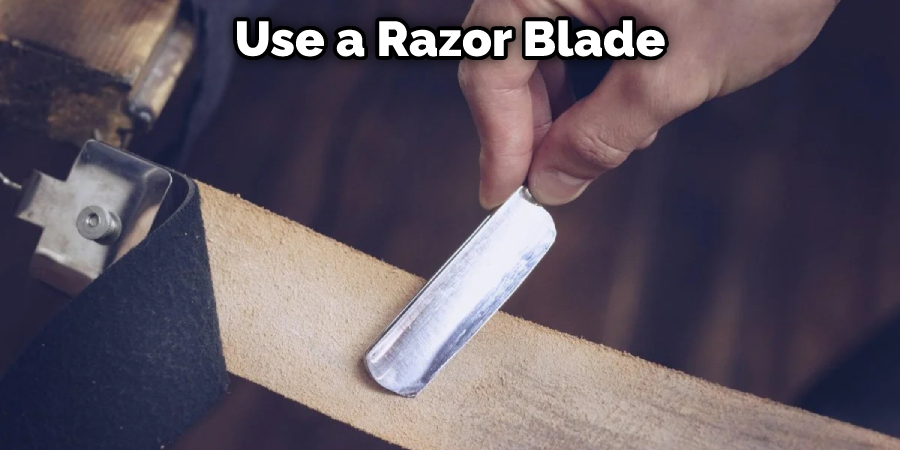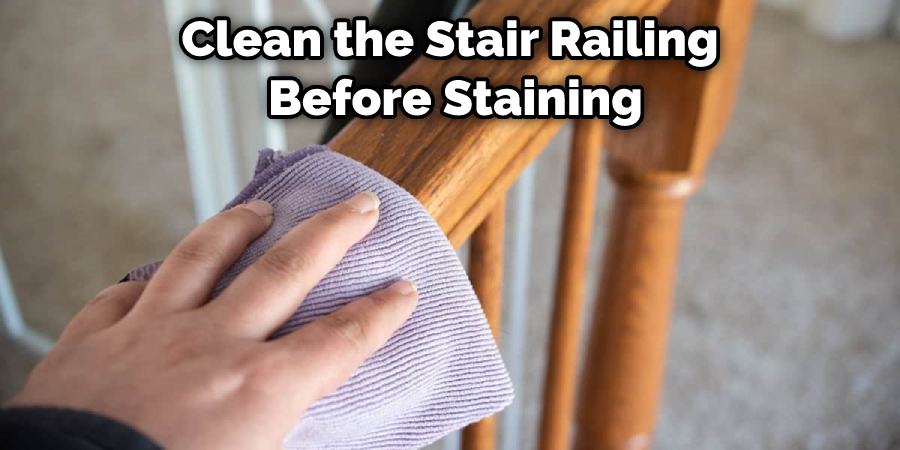Do you want to upgrade the look of your staircase without going through a major renovation? Refinishing and staining your stair railing can be a great way to get an elegant, finished look for a fraction of the price. Moreover, it is surprisingly easy to do with minimal time commitment!

In this blog post, we’ll go over exactly how to stain stair railing without sanding so that you can give your home’s interior a beautiful new makeover. With just some protective gear, stains & finishes, and a few basic tools (none of which are power-driven!), you’ll have renovated stairs in no time at all. Let’s get started!
Do You Have to Sand Railing Before Staining?
No, you do not have to sand the railing before staining. If the surface of your stair railing is already smooth and free from defects, then there is no need for sanding prior to staining. However, if your wooden railings are old or have any blemishes or scratches that could interfere with the stain’s adhesion and appearance, you should lightly sand the railing beforehand.
To ensure the best results, we recommend using a fine-grit (240) sandpaper to lightly sand the railing before staining. This will help to remove any dirt, debris, or imperfections from the surface of your stair railing and create an even base for your stain.
Be sure to wipe away any dust created by sanding before applying the stain. You may even want to use a vacuum cleaner to make sure all debris is removed from the railing’s crevices and grooves. After sanding, you are now ready to begin staining your stair railing.

Remember that following these steps can save you time and energy in the long run by creating a smooth base for your finish coat of stain. Taking the extra effort at this step can ensure that you get beautiful, professional results without needing to do any additional sanding after staining your stair railing.
10 Methods How to Stain Stair Railing without Sanding
1. Use a Paint Stripper.
Paint strippers are a great way to remove old paint from your stair railing without having to sand it first. Simply apply the stripper to the railing and let it sit for the recommended amount of time. Once it’s ready, use a putty knife or other scraper to remove the paint.
Be sure to wear protective gloves and eye protection when handling the stripper. Though it will effectively remove the old paint, it’s also very harsh and can irritate skin and eyes. However, you won’t need to sand the railing after using a paint stripper.
2. Use a Heat Gun.
A heat gun can also be used to remove paint from your stair railing. Simply hold the heat gun about six inches away from the surface of the railing and move it back and forth until the paint starts to blister and peel off. Once the paint has been removed, use a wire brush or sandpaper to smooth out any rough patches.
Be sure to wear protective gloves when using a heat gun, as the metal can get very hot. Although using a heat gun is an effective way to remove paint from your stair railing, it may take some time and patience. If you don’t feel comfortable using a heat gun, you may want to consider another option.
3. Use a Chemical Paint Remover.
There are a number of chemical paint removers on the market that can be used to remove paint from your stair railing without sanding. Simply apply the remover according to the instructions and wait for the paint to start peeling off.

Once it’s ready, scrape it off with a putty knife or other scraper. You may need to repeat this step several times if there are multiple layers of paint. Once all the old paint is removed, you’re ready to start staining your stair railing.
However, it is important to take all necessary safety precautions when using chemical paint removers. Be sure to use the appropriate personal protective equipment and work in a well-ventilated area.
4. Use Boiling Water.
If you don’t want to use any chemicals, you can try using boiling water to remove the paint from your stair railing. Simply pour a pot of boiling water over the area and let it sit for a few minutes. Once it’s had time to work, use a putty knife or other scraper to remove the paint. You may need to repeat this step a few times to get all the paint off.
Once you’ve finished, you should be left with a clean, paint-free surface that’s ready to be stained. Be sure to wear gloves and protective eyewear when handling boiling water. While this method is effective, it does take longer than other methods. To speed up the process, you can use a heat gun to remove the paint instead of boiling water.
5. Use an Electric Pressure Washer.
An electric pressure washer is another option for removing paint from your stair railing without sanding. Simply hold the pressure washer about six inches away from the surface of the railing and move it back and forth until the paint starts to blister and peel off.
This method requires less effort and time than sanding, but it could still take several hours to complete, depending on the size of your staircase. After using the pressure washer, you need to immediately clean up any paint chips that have come off and dispose of them in a safe manner.
6. Use an Orbital Sander.
An orbital sander can be used to remove paint from your stair railing without having to sand it by hand. Simply attach a 60-grit sanding pad to the sander and move it back and forth over the surface of the railing until the paint is removed.
Be sure to wear eye protection and a dust mask when using an orbital sander. To prevent creating deep scratches, move the sander in only one direction; do not circle it around the railing.
7. Use a Wire Brush.
A wire brush is another option for removing paint from your stair railing without sanding it first. Simply attach a wire brush to a drill and use the spinning bristles to remove the paint. Make sure you wear safety goggles when using this method, as flying fragments of paint can cause eye injury. Be sure to use the wire brush with care and don’t press too hard against the stair railing, as doing so can cause scratches.

8. Use a Chisel.
If you don’t want to use any power tools, you can try using a chisel to remove the paint from the stair railing. Start by using the chisel to lightly scrape off as much paint as possible. Once you have removed most of the paint, use a rag to wipe away any remaining residue.
Then move on to applying your stain or varnish. Be sure to apply evenly and around all sides of the rails. Finish up by wiping away any excess stains with a damp cloth. This method is ideal for those who have limited access to power tools or some experience in woodworking. Try to use a chisel made from durable material, such as stainless steel, to ensure the best results.
9. Use a Razor Blade.
A razor blade is another option for removing paint from your stair railing without sanding it first. To use a razor blade, lightly and carefully scrape the paint off of the stair railing. Be sure to use caution when using a razor blade, as it can cause damage to the wood if not done properly.

After you have removed all of the old paint, wipe the stair railing with a damp cloth or sponge to clean off any debris left behind. However, a razor blade is typically not the best option for removing paint from stair railings, as it can be difficult to get all of the old paint off without damaging the wood. Try to use a sanding block or sander if possible.
10. Use a Paint Scraper.
Finally, you can use a paint scraper to remove paint from your stair railing without sanding it first. To do this, be sure to use a sharpened paint scraper with a thin blade. You may want to hold the paint scraper at an angle and scrape in small sections so you can get as much of the old finish off as possible without damaging the railing.
Once all of the old finish is removed, you can then use a sanding block or sandpaper to smooth the surface of your stair railing for a new finish. Be sure to use light strokes when sanding and not too much pressure so as not to scratch the wood. Once done, you can wipe off the dust with a damp cloth before applying your stain.
Things to Consider When Staining Stair Railing without Sanding
1. Proper Preparation:
Before starting any staining project, it is important to protect the surfaces that will be touched and to make sure the environment is well-ventilated. Make sure to wear gloves and safety glasses, and open windows or doors for ventilation.
2. Cleaning:
It’s important to clean the stair railing before staining, using a mild cleaner or degreaser that won’t damage the surface. Wipe down with a damp cloth to remove any dirt or dust, then allow it to dry completely before proceeding.

3. Test area:
Before applying any stain, always test it on an inconspicuous area of the railing first in order to make sure you are happy with the results. This way, you can adjust your technique if necessary without ruining the overall effect of your project.
Conclusion
In conclusion, staining your stair railing doesn’t have to be a difficult or time-consuming task. With the right preparation and cleaning techniques, you can achieve professional-looking results in no time with minimal effort.
Furthermore, if you follow the right steps and use high-quality products, you can easily change the look of your stair railing without having to go through the hassle of sanding it down first.
Now that you know how to stain your stair railing without sanding, you can get started on this simple yet rewarding project! Take some time and really plan out the process, from softening the old finish to applying even layers of stain to get those desired results. So, don’t hesitate and start repainting those railings today – on How to Stain Stair Railing without Sanding!
You Can Check It Out to Make Wood Stain Dry Faster

